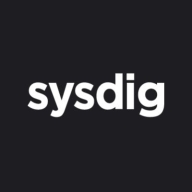

Qualys VMDR and Sysdig Secure are competitors in the vulnerability management and cloud-native protection categories, respectively. Qualys VMDR holds the upper hand in vulnerability management through its continuous monitoring and extensive feature set, while Sysdig Secure dominates in cloud-native environments due to its runtime detection and DevSecOps features.
Features: Qualys VMDR stands out with continuous monitoring, automatic detection, and comprehensive vulnerability management. It excels with its robust cloud-based infrastructure and detailed reporting. Sysdig Secure shines with cloud-native protection, with features emphasizing runtime detection and Kubernetes security, along with seamless cloud platform integrations.
Room for Improvement: Qualys VMDR could improve its interface and reduce false positives, streamline integration capabilities, and address its pricing complexity. Sysdig Secure should enhance its dashboarding and reporting, improve scalability, and provide more flexibility in agent bundling and Kubernetes event management.
Ease of Deployment and Customer Service: Qualys VMDR offers versatile deployment across various cloud environments but receives mixed reviews on support responsiveness. Sysdig Secure provides strong support tailored for cloud-native settings and generally receives high marks for customer service, although live support could be enhanced.
Pricing and ROI: Qualys VMDR faces high pricing challenges for small businesses, despite a generally positive ROI perception, while Sysdig Secure is commended for competitive pricing that fits cloud environments with straightforward licensing, both offering good ROI by enhancing cybersecurity and operational efficiency.
| Product | Market Share (%) |
|---|---|
| Qualys VMDR | 2.4% |
| Sysdig Secure | 2.7% |
| Other | 94.9% |
| Company Size | Count |
|---|---|
| Small Business | 20 |
| Midsize Enterprise | 12 |
| Large Enterprise | 69 |
| Company Size | Count |
|---|---|
| Small Business | 6 |
| Midsize Enterprise | 2 |
| Large Enterprise | 5 |
Vulnerability Management, Detection, and Response (VMDR) is a cornerstone product of the Qualys TruRisk Platform and a global leader in the enterprise-grade vulnerability management (VM) vendor space. With VMDR, enterprises are empowered with visibility and insight into cyber risk exposure - making it easy to prioritize vulnerabilities, assets, or groups of assets based on business risk. Security teams can take action to mitigate risk, helping the business measure their actual risk exposure over time.
Qualys VMDR offers an all-inclusive risk-based vulnerability management solution to prioritize vulnerabilities and assets based on risk and business criticality. VMDR seamlessly integrates with configuration management databases (CMDB), Qualys Patch Management, Custom Assessment and Remediation (CAR), Qualys TotalCloud and other Qualys and non-Qualys solutions to facilitate vulnerability detection and remediation across the entire enterprise.
With VMDR, users are empowered with actionable risk insights that translate vulnerabilities and exploits into optimized remediation actions based on business impact. Qualys customers can now aggregate and orchestrate data from the Qualys Threat Library, 25+ threat intelligence feeds, and third-party security and IT solutions, empowering organizations to measure, communicate, and eliminate risk across on-premises, hybrid, and cloud environments.
In the cloud, every second counts. Attacks move at warp speed, and security teams must protect the business without slowing it down. Sysdig stops cloud attacks in real time, instantly detecting changes in risk with runtime insights, a unique AI architecture, and open source Falco. Sysdig delivers live visibility by correlating signals across cloud workloads, identities, and services to uncover hidden attack paths. By knowing what is running, teams can prioritize the vulnerabilities, misconfigurations, permissions, and threats that matter most. From prevention to defense, Sysdig helps enterprises move faster and focus on what matters: innovation.
Sysdig. Secure Every Second.
We monitor all Container Security reviews to prevent fraudulent reviews and keep review quality high. We do not post reviews by company employees or direct competitors. We validate each review for authenticity via cross-reference with LinkedIn, and personal follow-up with the reviewer when necessary.